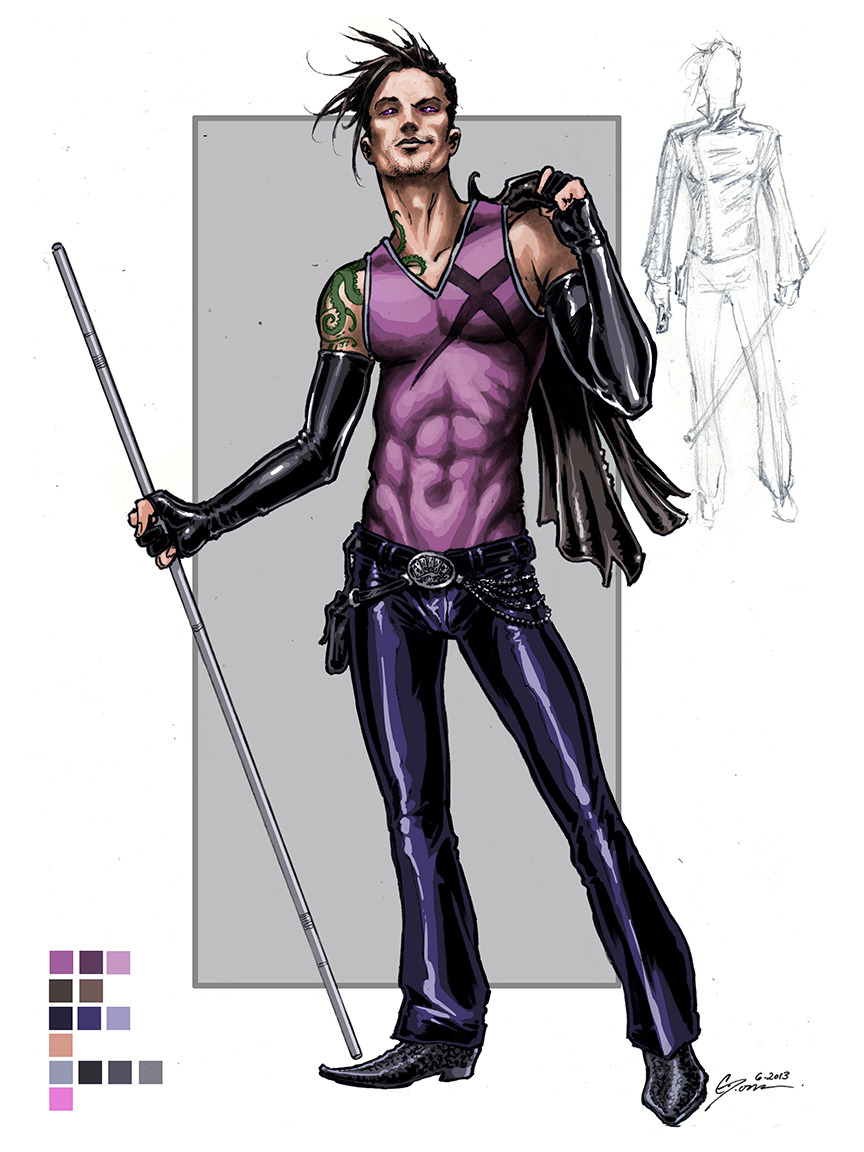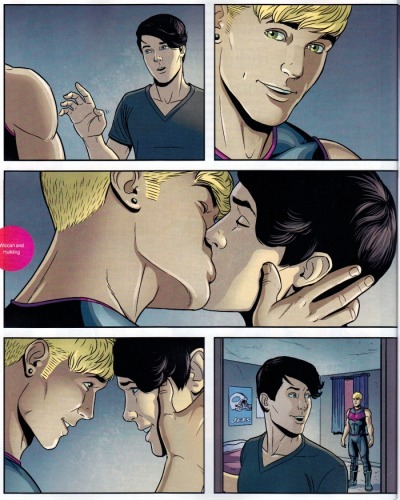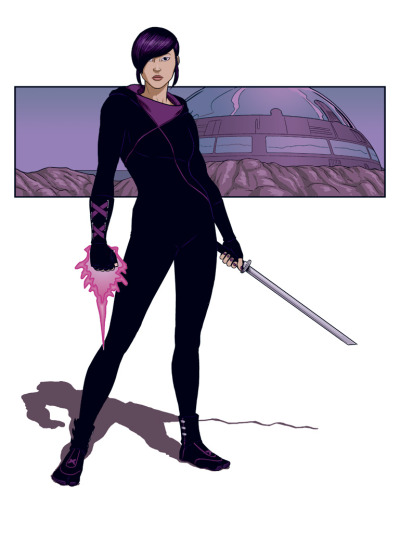Andrew Wheeler is a blogger and writer for Comics Alliance. Last year he wrote an article about Henry Cavill, British actor who played Superman in the 2013 movie, Man of Steel. During the article, Wheeler discusses the quality of Cavill’s acting ability, where he’s from, what he’s starred, in and more. He also talks about how attractive he finds Cavill (and I have to say, the scenes of shirtless Cavill when he’s saving the workers on the oil rig…yum yum):
How handsome is he, actually?
If you can’t see for yourself, let me make it plain; Henry Cavill is absurdly handsome. Implausibly handsome. He’s probably in contention for the title of “most handsome man that ever lived.” He’s so handsome that the entire entertainment industry has been secretly colluding to try to make him famous so they can put his face on things and sell them. He’s handsome.
Now, sure, some people will say, “Pfft, I prefer Benedict Cumberbatch”, and that’s OK. Weird, but OK. Henry Cavill is not the universal ideal; just the closest thing we have to it. If it weren’t for his very slightly bumpy nose he might actually be impossible to look at, but like a Persian rug he has one minor imperfection so as not to offend god.
Actually, he has two imperfections. He dresses terribly. Giant ties, ugly shoes, suits that fit like a balloon. Unless he gets a stylist post-Superman, watching Henry Cavill make fashion faux pas is going to become a new sport for supermarket tabloids.
In the United States, by and large, the discussion about movie stars often centers on the skills and abilities of male actors, and the appearance and beauty of female actors. In fact, that discussion extends beyond movie stars. Women are overwhelmingly valued for their appearance, rather than what they can do. Their worth is determined (by others) by how much they do or don’t eat, how much they do or don’t exercise, how much makeup they do or don’t put on, what type of clothes they wear, how they style their hair, how they look before, during and after pregnancy, and more. With men, the focus is much more on their skill set, their abilities, and their personality. The worth of a man is not determined by how he looks. Tabloid magazines don’t ceaselessly document what type of pants a male actor is wearing, how his hair looks on a windy day, or how well groomed his nails are. Yes, our culture does talk about men’s looks, but not the same way (or to the same degree) as we do with women’s looks. You can go to any bookstore and see men’s magazines (usually workout magazines) that focus on the appearance of men. They do exist, and they are part of the discussion. Unlike women, however, there isn’t an overwhelming focus on what men look like, nor is the value of men determined by their attractiveness.
One reader of Wheeler’s article took issue with how he talked about Cavill’s attractiveness:
Reblogging to point out how revolting this article is. After an overly-long introductory geography lesson, the author goes on to talk about Cavill the way most writers discuss actresses—by valuing only his looks. It’s gross. It isn’t okay to talk about women that way, and it isn’t okay to talk about Superman that way either.
Wheeler’s response was perfect:
Hi. I’m the author of this article. As you reblogged with my comment in-line, I assume you wanted to make sure that I saw your response, and I think you raised an important point, so I hope you won’t mind if I reply.
First, I’m sorry that you didn’t enjoy the article, and I appreciate your point of view.
However, I don’t agree with you, and I stand by my piece.
Before I explain why I don’t agree, I want to acknowledge that this is an important debate. Our culture talks about women in limiting ways. They are too often reduced to their looks – their hair, their clothes, their weight, their make-up. Hillary Clinton is asked questions that no-one would ever ask her husband. Whether a woman is a scientist, an executive, a writer, an intellectual, she will too often be judged for her attractiveness, and if she’s thought too pretty, she’ll be demeaned, and if she’s thought not pretty enough, she’ll be ridiculed. It is awful and unacceptable.
This happens in acting as well. Men are asked about their performance; women are asked about their appearance. A female actress experiencing a bad hair day, undergoing weight loss, weight gain, plastic surgery, or wearing sweatpants to pick up the kids from daycare, is considered a matter for public scrutiny.
I don’t like the magazines that run those pictures. I don’t like those websites. I don’t like those TV shows.
But that doesn’t mean we can never talk about looks. Acting is both a performance and an appearance business. An actor’s look is part of the package they sell, both to the industry and to the audience. How a person looks – or how a person can look – is part of the job, by design and for a reason. It’s part of creating a character. Sometimes an actor gets work because he or she looks quirky, intense, unusual, intelligent, ordinary, familiar.
Leading actors usually get work because they’re beautiful. There are other factors, but beauty is typically essential, because most popular entertainment is glamorous and glossy. It transports us to a world where stunning people face dramatically implausible challenges.
I like that glamour and gloss. I like beauty. I wish our media showed us the full, diverse and inclusive range of beauty, because I would love to find out if Godfrey Gao or Daniel Sunjata or Alex Meraz or Mehcad Brooks or Sung Kang could carry an action franchise on his back, but even so, I want to watch beautiful people do extraordinary things.
So it seems disingenuous to pretend that these people aren’t beautiful, or to avoid talking about something that is intrinsic both to the work they do and to why they get that work. What an actor wears to pick up the kids from daycare is nobody’s business, but what an actor wears on the red carpet is something we’re expected to have an opinion about, because we’re being sold something.
It’s not the only thing we should have an opinion about. We shouldn’t only talk about looks. We shouldn’talways talk about looks. But it is part of the cultural conversation.
And if we’re going to talk about looks, I think it’s important to talk about men.
Beauty should not be a one-way street focused solely on the male gaze towards the female body. Our appreciation of beauty should run in all directions. As a gay man, I’m used to being told that I should not publicise my attraction to other men. Women face enormous challenges to the free expression of their sexualities.
The very idea that a man could be a sexualised for the appreciation of women is foundation-shaking stuff for some. I was conscious of that when I wrote an article for a comics website drawing attention to a leading man’s attractiveness. I believe that acknowledging sex and sexuality is important, especially for marginalised groups. Silencing those conversations only serves the status quo.
Let’s talk about that status quo for a moment. The corollary to allowing straight and bisexual women to talk about attractive men is that we allow straight and bisexual men to talk about attractive women, right? And therein lies a danger, because straight men already do that, and they do it to the extent that it feels like a woman’s only value is her attractiveness. That takes us neatly back to where we started. To say that we can sometimes talk about female attractiveness creates an excuse for when we always talk about female attractiveness.
I think we need to exercise intelligent discretion on that point, because across-the-board repression is not a good solution. We need to talk about attractiveness as part of a balanced cultural diet.
Was my article all about Henry Cavill’s looks? No. The article talks about who he is, where he came from, what he’s done. But his looks are a big enough part of the article to make the headline.
The premise of the article is an introduction to Henry Cavill. I’ve been a fan for almost ten years, and let’s be clear: I’m a fan because he’s gorgeous. Breathtakingly so. He’s not an exceptional actor, but he is an exceptional beauty. His looks are important to his work. His looks are remarkable, and I remarked on them. (I also mentioned his dress sense, and I should clarify that I’m only talking about public appearances. You can read Tom & Lorenzo on the same subject here.)
If the article had only been about his looks, I think that would have been OK too. We can talk about that one thing in a landscape that includes many other things. Beauty, and what we find beautiful, is part of the language of culture. I think it’s a worthwhile topic.
For female actors, beauty is sometimes the whole of the landscape, and a feature of everything ever written about them. That should not be the case.
Female and male actors should be treated equally and afforded the same respect. They should be asked the same questions.
Sometimes we should talk about their looks.
Thanks again for sharing your opinion.
Wheeler is right. There’s nothing inherently wrong with talking about the attractiveness of men or women. The problem is when that discussion is overwhelmingly about beauty. When the vast majority of the discussion is how someone looks, rather than how they look plus what they can do and who they are as a person that’s when there is a problem. That’s a problem in the United States (and I imagine across the world). It isn’t a problem to talk about the beauty of a man. Not in the case of Wheeler’s article, because he also talks about other facets of Henry Cavill. It’s also not a problem to talk about the beauty of a man in general bc society as a whole also discusses other aspects of men. When society can catch up and do that very same thing to women–when a woman can be valued for her personality, her passion, her abilities, her skills, and her looks we’ll have made a greater stride toward equality*. I look forward to that day.
*The caveat I’ll add to that is the discussion of appearance must be relevant. The workplace is often the wrong place to discuss the attractiveness of others. Bosses shouldn’t discuss how much they find their subordinates, or peers. Context is important.






